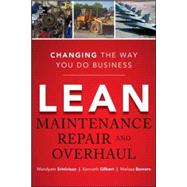BOOST PROFITS AND REDUCE COSTS BY EFFICIENTLY DELIVERING SUPERIOR MRO SERVICES
Lean Maintenance Repair and Overhaul describes how MRO organizations can achieve significant improvement in financial performance by applying the Theory of Constraints (TOC) to guide the implementation of Lean manufacturing tools. This Lean/TOC approach facilitates a growth strategy by providing customer value, such as faster turnaround times, that the competition cannot match. Lean/TOC creates the capacity for this growth by eliminating waste.
This practical guide shows how Lean/TOC also provides the improvement strategy for dealing with the variation that distinguishes MRO from high-volume, repetitive manufacturing. The methodology expands the improvement efforts beyond the manufacturing floor to make the organizational changes needed to facilitate growth and to empower the workforce to be enthusiastic participants in the improvement processes. You will learn how these concepts have been applied to MRO organizations in the commercial and defense sectors.
COMPREHENSIVE COVERAGE INCLUDES:
- The MRO business opportunity
- The goal of Lean and how Lean for MRO is different
- Achieving sustained growth in the MRO business
- Managing the MRO process
- Enabling flow in an MRO environment
- The Lean MRO toolkit
- Managing the back-shops
- Creating a visual culture for the implementation of Lean/TOC








